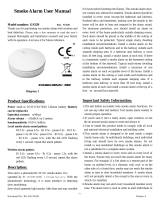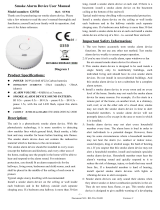Page is loading ...

1 GS869MANUALREVE
Gas Leakage Alarm User’s Manual
Model : GS869/GS869A
BS EN50194-1:2009
Licence No.: KM642335
Diagram 1
Thank you for purchasing this gas detector, which is intended to detect
leakage of natural gas.The detector that must connected to the mains power is
intended for installation in domestic premises (including static caravan holiday
homes).
Please take a few minutes to read the user’s manual thoroughly and
familiarize yourself and your family with its operation. And save it for
future reference.
Product Specifications:
Power Source : AC 220-240V / 50-60Hz
Sensor type : Semiconductor
Detector Gas : Natural Gas (Methane)
Sensitivity : 6% LEL (Lower Explosive Limit)
Sound Level : >85dB at 1 meter
Power Consumption : <4W
Dimension : 117.4×77.4×36.3mm
Temperature : -10℃~40℃
Humidity : 0~95% RH
Protection level : IPX2D
Product Life : 5 Years
Accessory (optional) : Solenoid valve
Solenoid valve Specifications (If applicable):
Control type: Normally open
Actuation voltage: DC 9V pulse voltage
Temperature: -10℃~ 60℃
Reset style: manual reset
Maximum pressure: 50Kpa
Flux: 25m3/h
Connection style: screw thread
Status
All statuses of the detector are showed in the summary table.
Summary Table
Status Illustration
Green
LED
Yellow
LED
Red
LED Horn Solenoid
valve
Self-Test Power on ON ON ON Chirp once open
Preheat About 180 seconds Light
0.5s/1s OFF OFF OFF open
Standby Normal condition Constant
on OFF OFF OFF open
Test Press key when
Preheat or Standby
Constant
on OFF Light
0.5s/1s
Synchronized
with Red LED close
ALARM Gas detected Constant
on OFF Light
0.5s/1s
Synchronized
with Red LED close
Silence Press key when
ALARM
Constant
on OFF Light
0.5s/1s OFF close
Sensor
Fault
The detector must
be replaced
Constant
on
Constant
on OFF chirp once per
30 seconds open
End of life The detector must
be replaced
Constant
on
Constant
on OFF chirp third times
per 30 seconds open
Power off The power wire is
unplugged OFF OFF OFF OFF open

2 GS869MANUALREVE
Emergency actions
If the detector initiates an alarm signal or there is a smell of gas, keep calm
and carry out the following actions, not necessarily in this order.
·Extinguish all naked flames, including all smoking material.
·Turn off all gas appliances.
·Do not switch on or off any electrical equipment, including the gas
detector.
·Turn off the gas supply at the gas main control.
·Open doors and windows to increase ventilation.
·Do not use a telephone in the building where gas may be present.
If the alarm continues to operate, even after an alarm resetting action,
where appropriate, and the cause of the leak is not apparent and/or cannot be
corrected, vacate the premises and IMMEDIATELY NOTIFY the gas supplier
and/or the gas emergency 24h-service in order that the installation may be tested
and made safe and any necessary repair carried out.
If the alarm stops or a latching alarm is reset according to the instructions
and the reason for the alarm having operated is identified, (for example a gas tap
switched on with the burner unlit), after stopping the gas release and ensuring
all appliances are turned off, the main gas supply may be reinstated and the
solenoid valve must be manual reset.
Even if the apparatus is fitted with a triggering device, for example for
closing a solenoid valve on the incoming gas pipe, the same procedure as
described above should be followed.
The detector should not be installed:
·directly above cooking appliances.
·in any outside location.
·in an enclosed space (e.g. in a cupboard or behind a curtain ).
·directly above a sink.
·next to a door or window.
·adjacent to an extractor fan.
·in an area where the temperature may drop below -10℃ or exceed 40℃.
·where dirt and dust may block the sensor.
·in a damp or humid location. =
Positioning of the gas detector
The gas detector should be installed in the room where a gas escape is most
likely to occur. This may be the kitchen because of the presence of a gas cooker
and other appliances.
Natural Gas is lighter than air, so the gas will tend to rise and fill all the
volume above the level of the escape. The gas detector should be installed above
the level of a possible gas escape and near the ceiling (about 0.3m from the
ceiling), in a place where air movement are not impeded by furniture and
furnishings. However apparatus with latching alarms should be positioned such
that user is able to access the TEST/HUSH button, andit is important that the
alarm signal can be easily heard in case of gas leakage.
Diagram 2

3 GS869MANUALREVE
General maintenance:
To keep your Gas Alarm in good working order, please follow these simple
steps:
1: Verify the unit's sound, LED light and the solenoid valve operation by
pushing the TEST/HUSH button once a week. Monthly checking if equipment
can work well by pushing a little gas from a cigar lighter near the ventilation
slots. If the unit is working normally, the unit will induce alarm.
Caution: Testing the detector with an uncontrolled source of gas (for
example a cigarette lighter) may give a misleading result and could damage
the detector. If induce a fault, please shut down and then reboot the device.
2: Remove the unit from the wall and clean the alarm cover and vents with
a soft brush attachment once a month to remove dust and dirt.
3: Never use detergents or other solvents to clean the unit.
4: Avoid spraying air fresheners, hair spray, or other aerosols near the GAS
Alarm.
5: Do not paint the unit. Paint will seal the vents and interfere with the
sensor's ability to detect the gas. Never attempt to disassemble the unit or clean
inside. This action will void your warranty.
6: As soon as possible, place the gas alarm back in its proper location to
assure continuous protection from methane.
7: When household cleaning supplies or similar contaminants are used, the
area should be ventilated.
If the alarm fails to operate, please send back to the address of
manufacturer shown on the back label of the detector.
Warning: Do not try to fix the detector yourself - this will void you
warranty!
Never attempt to repair the detector by yourself in order to prevent
possible hazards of electric shock or malfunction of gas alarm.
The service life of the gas alarm expires after approximately 5 years of
operation. Then, it should be replaced.
Warning: The following substances can affect the sensor and may cause
false or permanent damage:
Silicone vapors, hydrogen sulfide, Sulfur oxides,Chlorine gas, Hydrogen
chloride, alkaline metals, water, alcohol based products, propane, isobutene,
isopropanol, ethylene, benzene, toluene, ethyl acetate, paints, thinner, solvents,
adhesives ,hair sprays, after shaves ,perfumes and some cleaning agents etc.
Warning: If water freezes on the sensing surface, the sensing material
would crack, altering characteristics.
Warning: The detector cannot properly operate in a zero or low oxygen
content atmosphere. It requires the presence of around 21%(ambient) oxygen in
their operating environment in order to function properly.
Limited warranty
Purchase each new Gas Alarm device to be free from defects in material
and workmanship under normal use and service for a period of 1 year from the
date of purchase. Send the GAS Alarm with proof of purchase, postage and
return postage prepaid, to local distributor. This warranty does not cover damage
resulting from accident, misuse or abuse or lack of reasonable care of the
product. The liability of the company arising from the sale of this Gas Alarm
shall not in any case exceed the cost of replacement of GAS Alarm and in no
case shall the company be liable for consequential loss or damages resulting
from the failure of the Gas Alarm.
Siterwell shall have no liability for any personal injury or property damage,
or any special incidental, contingent or consequential damage of any kind
resulting from a gas leak. Your gas alarm is not a substitute for property,
disability, life or other insurance of any kind.
The detector is a sealed unit and cannot be repaired. If the unit is tampered
with it will invalidate the guarantee. If the unit is faulty please return it to you
original supplier with your proof of purchase.
This alarm is only suitable for private dwellings only and not intended for
commercial or industrial dwellings.
End of life
Replace it after 5 years of operation is recommended. When the
unit has come to the end of its life, this product should not be
disposed of with normal household waste. Please recycle where
waste electrical facilities exist. Check with your Local Authority or
retailer for recycling advice.

4 GS869 MANUAL REV E
Installation
This gas detector must be installed by a competent person.
The gas installation and shut-off device (where used) must comply with
the appropriate national regulations.
Electricity must be turned off before beginning installation to prevent
electrical shock or equipment damage.
Connect the output signal wire with the solenoid valve. (If applicable,
please refer to next section)
Having established the mounting location ensures that there is no electrical
wiring or pipe work in the area next to the mounting surface.
Mark the proper location on the wall according to the two holes of the
bracket of alarm. (Refer to diagram 3)
Drill two ф5.0mm holes in the wall, then insert the plastic plugs into the
holes.Attach the bracket to the plastic plugs and fix tightly the screws into the
plastic plugs.Fit the alarm on the bracket and pull it down until matching well
on the bracket.
Insert the power plug into the socket after installation, the power light will
be on. the gas detector will be in self- detection for about 3 minutes. During this
period, green LED is flashing.When it stops,the green LED is constant on, and
the detector is ready for use.
Additionally, any changes to the gas installation, e.g., fitting of an
automatic gas shut-off valve, must be carried out by a person qualified to the
national regulations for gas installations.
Note for installation of solenoid valve:
To prevent the possibility of death, serious injury or property damage,
close the electricity and gas supply pipeline before installation.
Removing impurities like metal powder and rust from the pipeline.
Ensure the solenoid valve is horizontal, i.e., the input and output port of
solenoid valve must keep on the horizontal level.
The solenoid valve can’t mount reversely, while there is a mark for gas
flow direction on the valve. (Refer to diagram 4)
External leakage tests must be carried out after installation.
Have any problem caused by solenoid valve, please call our agent.
Diagram 3
Diagram 4
Manufacturer: SITERWELL ELECTRONICS CO., LIMITED
ADDRESS: No.666 Qingfeng Road, Jiangbei District, Ningbo, Zhejiang Province,
China
TEL: 0086-574-87729581
FAX: 0086-574-87729581
E-MAIL: [email protected]
URL: www.china-siter.com
/






